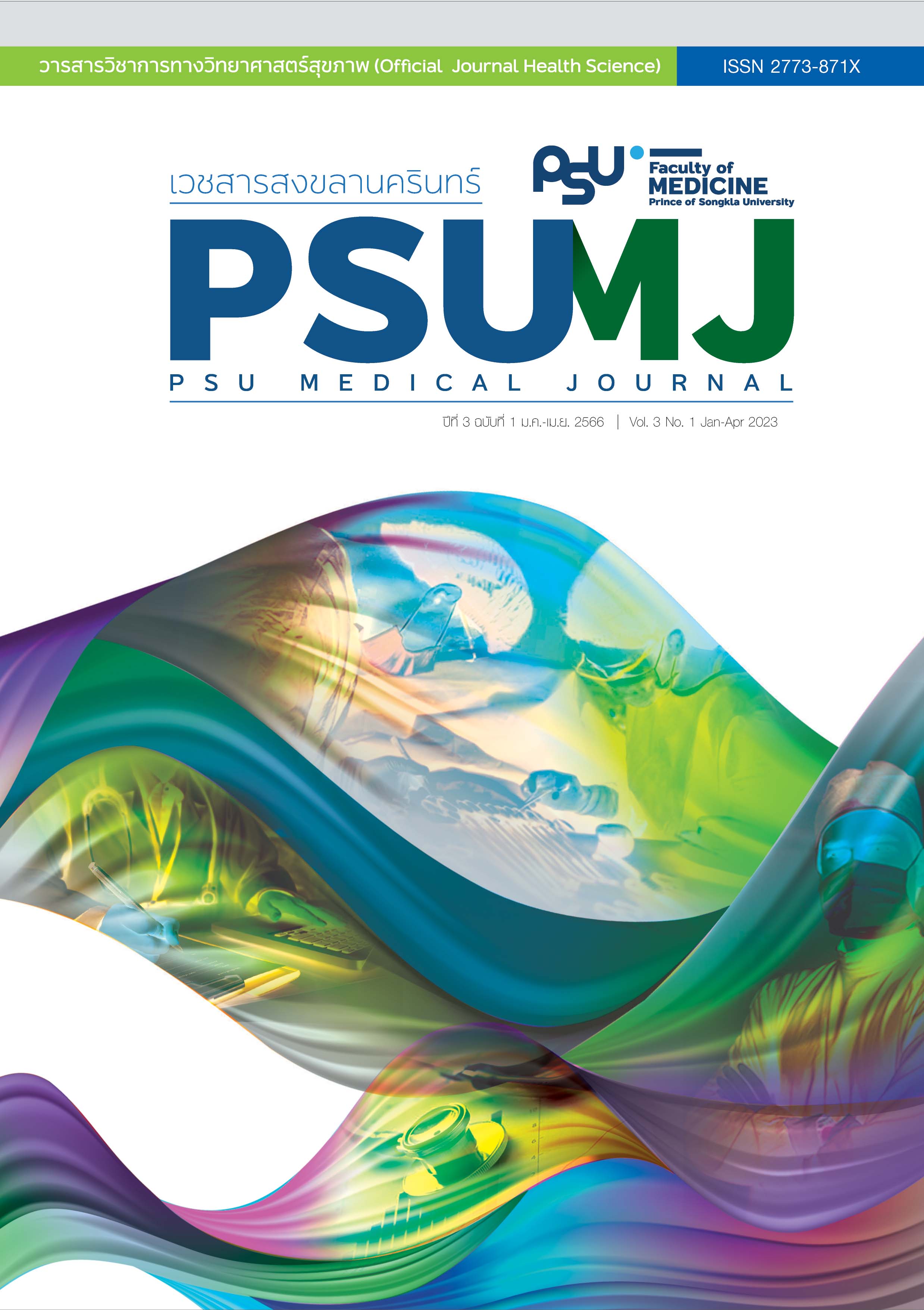Lived Experiences of Chronic Pain Patients Attending Follow-up Visits at a Pain Clinic During the COVID-19 Pandemic in Thailand
DOI:
https://doi.org/10.31584/psumj.2023258241Keywords:
chronic pain, COVID-19, experiences, pain clinic, pandemicAbstract
Objective: The whole world stopped turning, for most countries, due to shutdowns during coronavirus pandemics, with the exception of chronic pain patients. More than 40 years of unprecedented service changes in the pain clinic, under the COVID-19 era, could cause major impacts on patients living with chronic pain. We conducted this in-depth interview to evaluate how COVID-19 affected pain in patients with chronic pain.
Material and Methods: Face-to-face, in-depth interviews with tape recordings were used to explore the informants’ perspective, so as to capture their own words, thoughts, perceptions, feelings and experiences under the COVID-19 prevention and control measures. Field-notes and detailed memos were also recorded during the interview. The key informants consisted of 17 chronic pain patients, who came for follow-up visits at the pain clinic during the third and fourth waves of the COVID-19 pandemic. The qualitative content analysis method was employed to analyze the verbatim transcription of the interview recordings to identify themes and patterns.
Results: The findings revealed the key informants viewed COVID-19 as being closely tied with the perception of to what extent it impacted on maintaining their usual pain treatment and care as accessed. The key informants’ feelings of fear and worry were not generated from the effects of COVID-19 on their physical health, but were from the healthcare services changes and restrictions they faced. The ‘new normal’; as such social distancing, was viewed as similar and congruence with their long-lasting normal lifestyles. Talking about COVID-19 is a lot less interesting without talking about pain. The key informants preferred taking the risk of catching COVID-19, rather than coming back for untreated pain. The door-to-door pain medication delivery service provided a sense of uncertainty and could not replace the therapeutic feelings of a sense of heartwarming, care and safety generated while having face-to-face meetings with a doctor as well as acts of kindness and compassion from the pain clinic staff.
Three themes emerged from the findings: 1) the COVID-19 pandemic poses a threat to perceived stability on pain control; 2) embracing the ‘new normal’ in the world of chronic pain patients; and 3) a silver lining in the midst of the COVID-19 pandemic.
Conclusion: The way patients experienced the COVID-19 pandemic well reflects individual differences in the subjective experience of pain and individual needs of chronic pain patients. Changing of healthcare services utilization at pain clinics during the COVID-19 pandemic should be therefore concerned not only with the continuum of pain treatments, but also congruent to the care needs of chronic pain patients.
References
Saqib MAN, Siddiqui S, Qasim M, Jamil MA, Rafique I, Awan UA, et al. Effect of COVID-19 lockdown on patients with chronic diseases. Diabetes Metab Syndr 2020;14:1621-3.
Hoang SV, Nguyen KM, Le HTA, Tung AT, Huynh PVT, Le TV, et al. The effects of the COVID-19 lockdown on patients with chronic cardiovascular disease in Vietnam. J Infect Dev Ctries 2022;16:268-75.
Frenkel MO, Pollak KM, Schilling O, Voigt L, Fritzsching B, Wrzus C, et al. Stressors faced by healthcare professionals and coping strategies during the early stage of the COVID-19 pandemic in Germany. PLOS ONE 2022;17:e0261502.
Adeyemo OO, Tu S, Falako S, Keene D. Stressors on front line healthcare workers during the COVID-19 pandemic: a focus on moral injury and implications for the future. Int Arch Occup Environ Health 2022;1-8.
Johnston-Devin C, Oprescu F, Gray M, Wallis M. Patients describe their lived experiences of battling to live with complex regional pain syndrome. J Pain 2021;22:1111-28.
Fekadu G, Bekele F, Tolossa T, Fetensa G, Turi E, Getachew M, et al. Impact of COVID-19 pandemic on chronic diseases care follow-up and current perspectives in low resource set-tings: a narrative review. Int J Physiol Pathophysiol Pharmacol 2021;13:86-93.
Sakr CJ, Rahme D, Fakih L, Assaf SA, Redlich CA, Slade MD, et al. Anxiety among healthcare workers during COVID-19 pandemic in Lebanon: the importance of the work environment and personal resilience. Psychol Res Behav Manag 2022; 15:811-21.
Goni A, Hasan MJ, Kotseva K. Stress among health care workers (doctors and nurses) as an impact of COVID-19 pandemic. Open Access Library J 2022;9:1-29.
Monaghesh E, Hajizadeh A. The role of telehealth during COVID-19 outbreak: a systematic review based on current evidence. BMC Public Health 2020;20:1193.
National Health Service England. Millions of patients benefiting from remote consultations as family doctors respond to COVID-19. England: National Health Service England; 2020 [cited 2022 Aug 1]. Available from: http://www.england.nhs. uk/2020/05/millions-of-patients-benefiting-from-remote-consultations-as-family-doctors-respond-to-COVID-19
Spencer J, Oung C. How has lockdown affected general practice and where do we go from here? [homepage on the Internet]. London: Nuffield Trust; 2020 [cited 2022 Aug 1]. Available from: https://www.nuffieldtrust.org.uk/news-item/how -has-lockdown-affected-generalpractice-and-where-do-we-go-from-here
National Health Service. Clinical guide for the management of remote consultations and remote working in secondary care during the coronavirus pandemic. NHS specialty guide. [homepage on the Internet]. England: National Health Service England; 2021 [cited 2022 Aug 1]. Available from: https:/www. rcslt.org/wp-content/uploads/2021/10/NHS-England-clinical-guide-for-the-management-of-remote-consultations-and-remote-working-in-secondary-care-during-the-coronavirus- pandemic.pdf
Balestra AM, Chalk K, Spies C, Denke C, Krampe H, Tafelski S. Living with chronic pain during the COVID-19 pandemic: a qualitative analysis. J Pain Res 2022;15:969-81.
Karos K, McParland JL, Bunzli S, Devan H, Hirsh A, Kapos FP, et al. The social threats of COVID-19 for people with chronic pain. Pain 2020;161:2229-35.
Singh K, Kaushik A, Johnson L, Jaganathan S, Jarhyan P, Deepa M, et al. Patient experiences and perceptions of chronic disease care during the COVID-19 pandemic in India: a qualitative study. BMJ Open 2021;11:e048926.
Mohamed Ali O, Borg Debono V, Anthonypillai J, Hapidou EG. A qualitative study of the impact of the COVID-19 pandemic on a sample of patients with chronic pain. J Patient Exp 2022; 9:23743735221089698.
Keen S, Lomeli-Rodriguez M, Williams ACC. Exploring how people with chronic pain understand their pain: a qualitative study. Scand J Pain 2021;21:743-53.
Dassieu L, Pagé MG, Lacasse A, Laflamme M, Perron V, Janelle-Montcalm A, et al. Chronic pain experience and health inequities during the COVID-19 pandemic in Canada: quali-tative findings from the chronic pain & COVID-19 pan-Canadian study. Int J Equity Health 2021;20:147.
Doyle L, McCabe C, Keogh B, Brady A, McCann M. An overview of the qualitative descriptive design within nursing research. J Res Nurs 2020;25:443-55.
Anas N, Ishaq K. Qualitative research method in social and behavioural science research. IJMSSPCS 2022;5:89-93.
Toles M, Barroso J. Introduction to qualitative research. In: LoBiondo-Wood G, Haber J, editors. Nursing research: methods and critical appraisal for evidence-based practice. 9th ed. St. Louis:Elsevier;2018:149-64.
Shava GN, Hleza S, Tlou F, Shonhiwa S, Mathonsi E. Quali-tative content analysis, utility, usability and processes in educational research. IJRISS 2021;553-8.
Marvasti A. Qualitative content analysis: a novice’s perspec-tive. Social Science Open Access Repository 2019;20:A32.
Braun V, Clarke V. Conceptual and design thinking for thematic analysis. Qual Psychol 2022;9:3-26.
Hashimov E. Qualitative data analysis: a methods source-book and the coding manual for qualitative researchers. Technical Communication Quarterly 2015;24:109-12.
Renz SM, Carrington JM, Badger TA. Two strategies for qualitative content analysis: an intramethod approach to triangulation. Qual Health Res 2018;28:824-31.
Henage CB, Ferreri SP, Schlusser C, Hughes TD, Armistead LT, Kelley CJ, et al. Transitioning focus group research to a videoconferencing environment: a descriptive analysis of in teractivity. Pharmacy (Basel) 2021;9:117.
Bradshaw C, Atkinson S, Doody O. Employing a qualitative description approach in health care research. Glob Qual Nurs Res 2017;9:1456-64.
de Moraes ÉB, Santos Garcia JB, de Macedo Antunes J, Daher DV, Seixas FL, Muniz Ferrari MF. Chronic pain man-agement during the COVID-19 pandemic: a scoping review. Pain Manag Nurs 2021;22:103-10.
El-Tallawy SN, Nalamasu R, Pergolizzi JV, Gharibo C. Pain management during the COVID-19 pandemic. Pain Ther 2020;9:453-66.
Lynch ME, Williamson OD, Banfield JC. COVID-19 impact and response by Canadian pain clinics: a national survey of adult pain clinics. Can J Pain 2020;4:204-9.
Byrne L. Reimagining person-centred care-in the public square. J Patient Exp 2022;9:1-4.
Dong L, Chen L, Ding S. Illness uncertainty among patients with COVID-19 in the Mobile Cabin Hospital. Nurs Open 2022;9:1456-64.
Payán DD, Frehn JL, Garcia L, Tierney AA, Rodriguez HP. Telemedicine implementation and use in community health centers during COVID-19: clinic personnel and patient perspectives. SSM Qual Res Health 2022;100054.
Downloads
Published
How to Cite
Issue
Section
License
Copyright (c) 2023 Author and Journal

This work is licensed under a Creative Commons Attribution-NonCommercial-NoDerivatives 4.0 International License.








